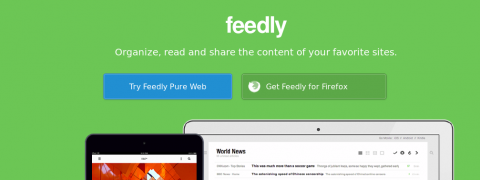Google’s decision to scrap Google Reader drove people to seek alternative RSS feed readers. Lots of us migrated to The Old Reader, which described the heavy influx of traffic from March onwards as “a nightmare” and took the decision to close user registration and shut the public site down. (At the time of writing, they are discussing “new proposals” which may reverse this decision.)
Now the weary travellers who moved to The Old Reader must find a new home. I’ve heard a lot of recommendations for Feedly, so I decided to try it.
I was viewing the page in Firefox, and I tried clicking on Product Tour to get an idea of what Feedly does. The first thing I saw when I got to this page was a choice: Try Feedly Pure Web or Get Feedly for Firefox.
But there’s a question you might want answered before you make that decision: “What is Feedly Pure Web?” (Also, I clicked on “Product Tour” because I wanted a product tour, not a sign-up page.)
Clicking on Try Feedly Pure Web doesn’t answer your question. (Not even if you then click Explore; it won’t actually tell you what it is.)
The About page doesn’t answer your question either. It gives you nice pictures of the Feedly team, with cutesy quotes, but no info at all.
The Help page doesn’t answer the question. Typing the questions “What is Pure Web?” or “What is Feedly Pure Web?” into the search box won’t help either.
I eventually got an answer by googling the question, which took me to a blog post on the Feedly site, posted in June, which answers the question in a roundabout way by announcing “A pure web interface” which I assume is the same thing as “Feedly Pure Web”, though at no point does the blog post use that exact phrase. A little more googling confirmed my assumption.
Why am I banging on about this? Because I clicked “Product Tour” wanting information. Instead, I was given a choice between two options and not given a clue what one of those options actually was. (My first guess was that "Pure Web" was a mobile-only version of the reader.) And it’s a time-consuming hassle, requiring persistence and web literacy, to get an explanation. This is the kind of thing Kathy Sierra is talking about when she says:
If your UX asks the user to make choices, for example, even if those choices are both clear and useful, the act of deciding is a cognitive drain. And not just while they're deciding... even after we choose, an unconscious cognitive background thread is slowly consuming/leaking resources, "Was that the right choice?"
If your app is confusing and your tech support / FAQ isn't helpful, you’re drawing down my scarce, precious, cognitive resources.
Anyway, now I’ve found out the answer to my question, I think I should share it with the rest of the class.
Feedly Pure Web is a standalone Web version of Feedly, available from any browser (including Opera and Internet Explorer). It doesn’t require any brower plug-ins or extensions to work. It’s powered by Feedly Cloud.
In other words, it was the option I wanted, and probably the option you want too. If you’re happy to sign up instantly, getting zero information from the Feedly site itself, you can just sign up on the homepage. You’re spared the angst because the cloud/Pureweb version is the only version offered then and you’ll have no idea the Firefox option exists. But if you don’t like the idea of signing up without getting some information first, things get much more difficult. The Feedly user interface is penalising people who want to do some (minimal) research before signing up to a new service.
